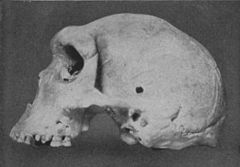Homo rhodesiensis
| Homo rhodesiensis | |
| Woodward, 1921[1] | |
 Czaszka znaleziona w 1921 | |
| Systematyka | |
| Domena | |
|---|---|
| Królestwo | |
| Typ | |
| Podtyp | |
| Gromada | |
| Infragromada | |
| Rząd | |
| Rodzina | |
| Rodzaj | |
| Gatunek | Homo rhodesiensis |
Homo rhodesiensis – nazwa zaproponowana dla gatunku hominida, którego czaszkę znaleziono w kopalni żelaza i cynku w Rodezji Północnej w 1921 roku przez Toma Zwiglaara, szwajcarskiego górnika. Szacowany okres występowania: 300–120 tys. lat temu. Obszar występowania: Zambia.
Współcześnie Homo rhodesiensis przypisywany jest do czasem gatunku Homo heidelbergensis lub Homo helmei (włączany z kolei do Homo sapiens)[2].
Przypisy
- ↑ Arthur Smith Woodward. A New Cave Man from Rhodesia, South Africa. „Nature”. 108 (2716), s. 371–372, 1921. DOI: 10.1038/108371a0. (ang.).
- ↑ Margaret Avery. Micromammals from the type site of Broken Hill Man (Homo rhodesiensis) near Kabwe, Zambia: a historical note. „Historical Biology”. 30(1-2), s. 276-283, 2018. DOI: 10.1080/08912963.2017.1297434. [dostęp 2022-10-18]. (ang.).
Media użyte na tej stronie
Autor: (of code) -xfi-, Licencja: CC BY-SA 3.0
The Wikispecies logo created by Zephram Stark based on a concept design by Jeremykemp.
Autor: High Contrast, Licencja: CC BY 3.0 de
Anthroplogy - human skull of a boy. The skull is of a boy that was likely about 8 years old. The age of the skull itself is not known. Note the mandibular central incisors breaking through.
(c) Oryctes, CC BY-SA 3.0
Cast of the Sahelanthropus tchadensis holotype cranium TM 266-01-060-1, dubbed Toumaï, in facio-lateral view.
Photo: British Museum (Natural History).
SIDE-VIEW OF A PREHISTORIC HUMAN SKULL DISCOVERED IN 1921 IN BROKEN HILL CAVE, NORTHERN RHODESIA
Very striking are the prominent eyebrow ridges and the broad massive face. The skull looks less domed than that of modern man, but its cranial capacity is far above the lowest human limit. The teeth are interesting in showing marked rotting or "caries," hitherto unknown in prehistoric skulls. In all probability the Rhodesian man was an African representative of the extinct Neanderthal species hitherto known only from Europe.Autor: Thomas Roche from San Francisco, USA, Licencja: CC BY-SA 2.0
Homo erectus, Museum of Natural History, Ann Arbor, Michigan, November 2007.
Autor: Autor nie został podany w rozpoznawalny automatycznie sposób. Założono, że to Alberto Salguero (w oparciu o szablon praw autorskich)., Licencja: CC-BY-SA-3.0
Pablo Alberto Salguero Quiles







